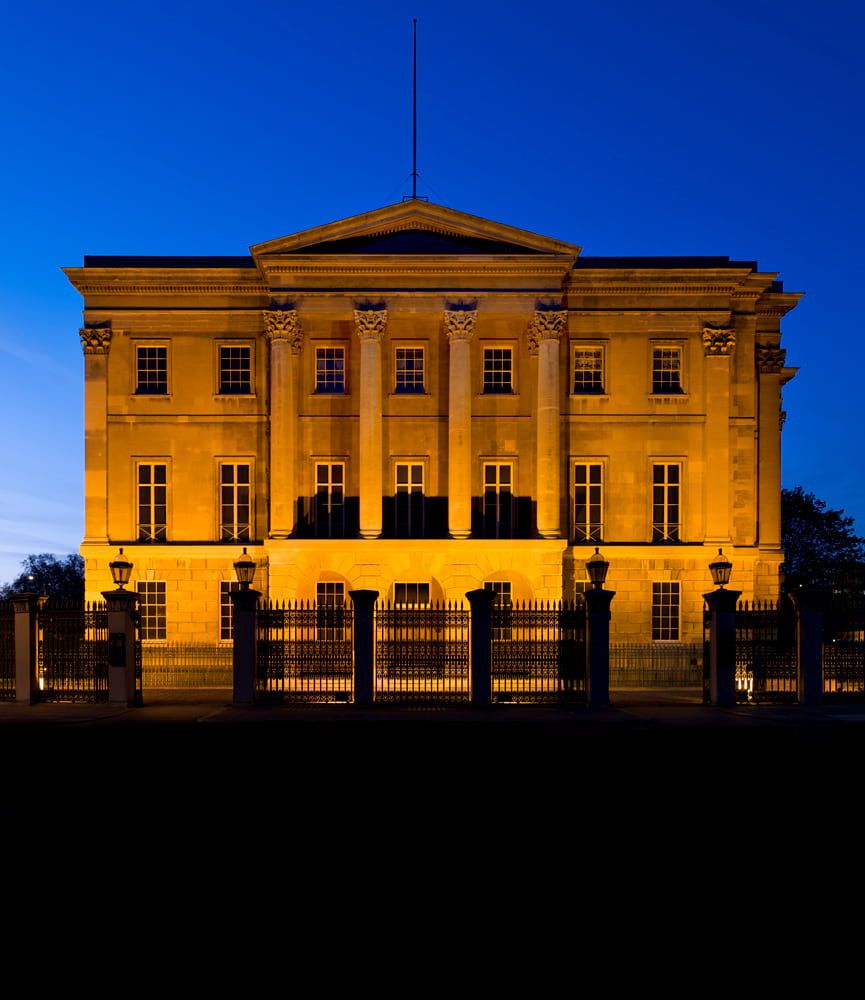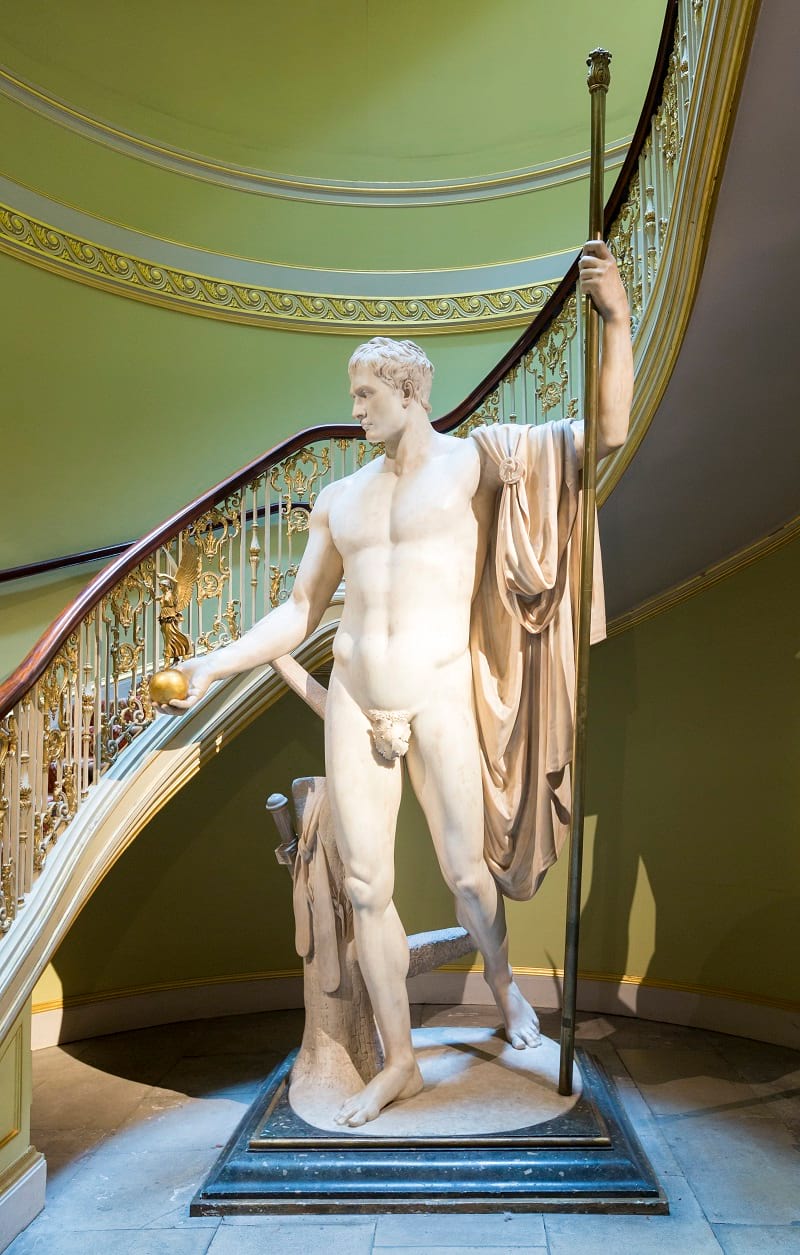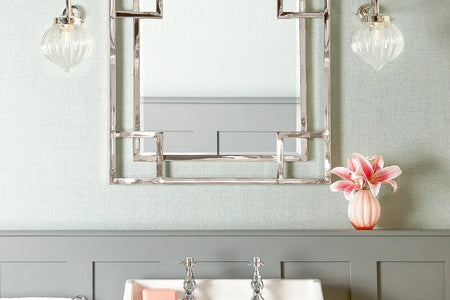 Image: English Heritage
Image: English Heritage
Our search for the most beautiful interiors in Britain continues with a look at Apsley House – the town residence of the Duke of Wellington, and one of London’s great ‘hidden gems’…
By Nigel Andrew
A couple of hundred years ago, Apsley House was the first large building you came across as you entered London from the West, through the then rural village of Kensington. Hence its popular address – ‘Number One London’. Today Apsley House, the town residence of the Dukes of Wellington, stands somewhat marooned between Hyde Park and Piccadilly, its grand entrance front overlooking the endless swirl of traffic around Hyde Park Corner. The house is one of a tiny handful of its kind in London that are open to the public, and it contains some of London’s most spectacularly palatial interiors – and yet visitors and Londoners alike tend to overlook it. They don’t know what they’re missing. Not only is this a fine late Georgian town house, it is also an art gallery of national importance, with several paintings that would be worth the trip even if they weren’t hanging in such glorious surroundings.
 Image: English Heritage
Image: English Heritage
Adam and Wyatt
Apsley House began life as an Adam house, designed inside and out by the great Scottish architect and interior designer Robert Adam (see Amazing Interiors: Osterley). It was an externally simple, box-like house of red brick, but what we see today – a much extended building clad in beautiful Bath stone and furnished with an impressive portico – is mostly the product of later work undertaken for the first Duke of Wellington, the hero of Waterloo, by Benjamin Dean Wyatt in the 1820s. And the inside presents a similarly mixed picture. To enter by the front door, leaving behind the roar of the Hyde Park Corner traffic and stepping into the sudden quiet of the entrance hall, is a delight. The hall is a cool, understate space, flanked by marble pillars and lined with busts and portraits – the first of many that adorn the house, most of them of contemporaries and comrades-in-arms of the hero of Waterloo. The first showpiece interior is a stunner – the yellow and gilt stairwell from which a grand gilded staircase rises elliptically to a skylight high above. In its present form this is Wyatt’s work, and very successful it is. But what catches the eye – to the point where you can hardly stop staring – is the gigantic, more than a little absurd statue of Napoleon as Mars the Peacemaker. Carved by Antonio Canova, this shows Napoleon nude and in a highly idealised, god-like form – ‘trop athlétique’, as Bonaparte remarked, leaving it covered up in the Louvre to languish unseen. However, after Waterloo, the British government decided to buy it and present it to Wellington, who could hardly refuse the gift. Taking care to reinforce the floor to withstand the weight of all that marble, the Duke installed this extraordinary statue at the foot of the stairs, where it still stands, immovable and looking ever more ridiculous with the passing of the years. You can’t help but notice – well, I couldn’t – how small is the fig leaf that covers the Imperial privities… 'Napoleon as Mars the Peacemaker'. Image: English Heritage
'Napoleon as Mars the Peacemaker'. Image: English Heritage
Wellington and Waterloo
The suite of formal rooms on the first floor begins with the Piccadilly Drawing Room, in which an Adam ceiling, chimneypiece and frieze survive. The walls are hung with yellow satin, as in Wyatt’s decorative scheme – and with some remarkable paintings. The greatest of these is the Titian Danaë, which research has shown to be the version that Philip II bought direct from the artist. Like many of the masterpieces at Apsley House, this was Napoleonic plunder, taken from the Spanish royal collection, retrieved after Waterloo, then gratefully presented to Wellington. Piccadilly Drawing Room. Image: English Heritage
Piccadilly Drawing Room. Image: English Heritage
The Portico Drawing Room retains an Adam flavour, with its delicately ornamented ceiling, frieze and chimneypiece, but the huge pier glasses, overmantel and pier tables were designed by Wyatt. An impressive, glittering chandelier – one of many in Apsley House – hangs from the ceiling, and the walls are again lined with paintings, including an early equestrian portrait of Wellington by Goya (who seems to have added the Duke’s head to a composition he had already begun). The undoubted highlight of the tour is the breath-taking Waterloo Gallery, which has been aptly described as ‘one of the great palatial interiors of Britain’– and palatial it was intended to be. This vast room, some 90ft long, was designed not only to serve as a setting for the annual celebratory Waterloo Banquet of veterans and dignitaries, but also to impress British and foreign royalty, statesmen, ambassadors and political leaders, with all of whom Wellington regularly consorted. To achieve this effect, Wyatt – who added the two-storey Gallery to the house – ignored all the styles fashionable in the late 1820s and looked to the age of Louis XIV for inspiration, creating what is in effect an interpretation of the Galerie des Glaces at Versailles. With its tall mirrored shutters lining one wall, its extravagant gilding and highly ornate ceiling, this interior breathes the spirit of the ancien régime. Two huge torchères and another mighty chandelier provide the lighting, and the walls are hung with red silk, though originally Wellington had gone for yellow damask, despite the misgivings of his friend and adviser on domestic matters, Mrs Arbuthnot: ‘He is going to hang it with yellow damask, which is just the very worst colour he can have for pictures and will kill the effect of the gilding. However, he will have it.’
 The Waterloo Gallery. Image: English Heritage
The Waterloo Gallery. Image: English Heritage
Mrs A was quite right – the pictures do indeed look better against red. And what pictures! Here are the jewels of Wellington’s collection of paintings from the Spanish royal collection, including four by Velazquez – two great portraits, a genre scene of young men eating and The Water Seller of Seville, a painting that is one of Velazquez’s supreme masterpieces. These are treasures indeed, and there are more on the walls of this magnificent gallery, including a very fine Portrait of an Unknown Man by Murillo and the First Duke’s special favourite, a Correggio Agony in the Garden, which to modern eyes looks a little insipid.
 The Waterloo Gallery. Image: English Heritage
The Waterloo Gallery. Image: English Heritage
 The Waterloo Gallery. Image: English Heritage
The Waterloo Gallery. Image: English Heritage
 Velasquez - 'The Water Seller of Seville'
Velasquez - 'The Water Seller of Seville'
Busts and Banquets
A door from the Waterloo Gallery leads back into the original Adam house. The Yellow Drawing Room has its original Adam fireplace but is mostly a Wyatt interior. On a side table is a bust by Canova, on a very much smaller scale than the Napoleon at the foot of the stairs. It is one of four ‘ideal’ heads presented by the sculptor to the British gentlemen who oversaw the return to Rome of art treasures looted by Napoleon for the Louvre. The Striped Drawing Room was created by Wyatt from three rooms of the Adam house. The distinctive striped hanging and furniture covers might well have been inspired by the famous Tent Room in Napoleon’s apartment at Malmaison. Wellington turned the room – where guests could relax before passing through to the State Dining Room – into a gallery of heroes, lined with portraits of his illustrious comrades in arms as well as political figures, and Napoleon himself. There is also, fittingly, a large panoramic painting of The Battle of Waterloo by Sir William Allan – the Duke’s verdict on seeing it at the Royal Academy was ‘Good, not too much smoke’. Striped Drawing Room
Striped Drawing Room
One more grand interior completes the tour of the state rooms. The State Dining Room was part of Wyatt’s three-storey addition to the Northeast of the house. It was here, until the building of the Waterloo Gallery, that the annual Waterloo Banquet was held. It also embodies Wellington’s uniquely exalted position as one of the great men of Europe, on near-equal terms with the dignitaries whose state portraits, presented by themselves, line the walls. The setting leaves no doubt of what grand affairs the Waterloo Banquets were. Beneath a fabulously ornate chandelier the long, wide table is set with part of the Portuguese Service, a glittering silver-gilt extravaganza presented to Wellington by the Portuguese Council of Regency in 1816. The centrepiece, which runs the length of the table, represents the four continents paying tribute to the victorious armies of the Peninsular War. Elegant candelabra rise at intervals, and dancing nymphs encircle the whole. Amazingly, there is yet more of this service on display in the museum room on the ground floor. It adds up to more than a thousand pieces – that’s quite an expression of gratitude.
 State Dining Room. Image: English Heritage
State Dining Room. Image: English Heritage
Apsley House (the upper rooms of which are still used by the family) was donated to the nation in 1947, and the house as we see it now is largely the result of a long campaign of restoration begun in 1977 by the Victoria and Albert Museum and continued to the present under the auspices of English Heritage. It has been a sensitive and expert restoration, successfully re-creating the atmosphere of a great London town house that became something very like a palace. More people should come to see it. Our thanks for English Heritage for their help and the use of images. Plan your visit to Apsley House here. At Pooky we make beautiful lighting for beautiful interiors. Browse our lamps and lampshades here.










